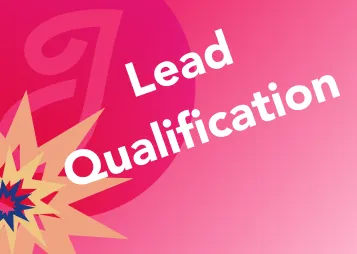If your pipeline has been carefully designed with your ICP in mind, qualified leads should move through it with no problems or unexpected dropouts. That’s the dream, right?
But as we know, somehow unqualified or badly-qualified leads always find their way in, muddying your visibility on sales pipeline and wasting your team resources.
Lead qualification in the early stages is crucial to ensuring a healthy flow of good-quality leads through a watertight pipeline. I have never been proven wrong on this belief in all my years in business.
Let’s explore the critical role of lead qualification and why I believe it is the silver bullet that addresses the issue of sales pipeline leakage.
Why poor lead qualification is a threat to visibility
Before I get into the nitty-gritty of lead qualification, it's essential to understand the wide-reaching implications of poor lead qualification on your sales pipeline and, subsequently, your revenue.
Inadequate lead qualification can pose a significant threat to your pipeline's visibility, hindering your ability to forecast accurately.
At the end of the day, you need to be converting good-quality leads at each stage of your pipeline at the right time and in the right order to have true pipeline visibility.
When your sales team is inundated with unqualified leads, they might spend a considerable amount of time pursuing prospects who are not genuinely interested in or a good fit for your product or service.
Without a clear view of your pipeline, it becomes challenging to make informed decisions, allocate resources efficiently, and set realistic revenue targets.
Chaos ensues.
Your forecasting accuracy suffers, you risk missing growth opportunities and allocate resources where they won't yield the returns.
Risks that cannot be afforded, whatever the state of your market.
The role of lead qualification
Lead qualification acts as the gatekeeper that ensures only leads with the highest potential to convert into paying customers move through your sales pipeline. By implementing a robust lead qualification process, you can categorize leads based on their fit, interest, and buying intent.
A well-qualified lead provides valuable insights into their needs, pain points, and where they are in the buying journey. Armed with this information, your sales team can tailor their approach, making the sales process more efficient and improving the chances of conversion.
Note: lead qualification is not a once-and-done. It should be an ongoing pursuit that guides your sales team in their work and steers your prospects through the sales pipeline.
Why bad lead qualification = pipeline stagnation
When leads get stuck at various stages in your pipeline, progress of all leads (good and bad) is stunted as resources are tied up. In my experience, this almost inevitably leads to pipeline leakage.
Here’s why.
Bad lead qualification results in leads being moved through the pipeline without a clear understanding of their true or desired destination. As a consequence, sales teams waste time and effort on leads that are unlikely to convert, and these leads take up valuable pipeline space. If you're not using sales pipeline management software, this is a real threat.
When leads stagnate, the entire pipeline becomes clogged and our sales team becomes overwhelmed. The result is a lack of movement and progress, causing frustration within the team and significant risks to your pipeline.
Ask yourself, are there leads in your pipeline that shouldn’t be there? It might make the pipe look good for your pipeline review, but it won’t be a good look in 6 month’s time.
Knowing your qualification criteria
Defining and knowing your qualification criteria protects your pipeline health. And this needs to be knowledge shared across both the sales and marketing teams.
Qualification criteria are the specific characteristics, behaviors, and engagement metrics that determine whether a lead is a good fit for your product or service. Start with being clear on your ICP and doing some internal education around how this plays out in the real world.
To expand on and test your qualification criteria:
Consider the quality of leads from each of your lead sources. How are they different and why?
Review the leads you have lost that you considered good quality. Were you right to lose them and why?
Lastly here, be aware that qualification criteria should not remain static. Market conditions change, as do your product offerings and ICP characteristics. Regularly review and adjust your qualification criteria with your front-line team to ensure they remain aligned with your business goals and the market.
The lead qualification conversation
Defined sales methodologies and lead qualification processes ensure consistency across your team. A well-crafted script will make for a structured framework for your sales team to follow, ensuring that they ask the right questions and gather the necessary information to make informed decisions.
That said, remember that humans are complex creatures and no conversation will follow your script exactly. It’s important your team feel confident being dynamic and responsive to each prospect they speak to, exploring their own individual situation. What’s important - script or no script - is asking the right questions.
Why you should disqualify as much as you qualify
In the never-ending quest to fill the sales pipeline, it's easy for reps to fall into the trap of incorrectly qualifying or partially qualifying every lead that comes their way. In simple terms, the more leads they’re chasing, the better they look.
But in reality, disqualifying leads can be just as important and beneficial to the business as qualifying, if not more so.
Disqualifying leads that don't meet your criteria or show a lack of interest serves three key purposes - which all impact revenue in a very tangible way:
#1 Resource allocation - so you can free up valuable resources to focus on leads with higher conversion potential.
#2 Time management - invest team time and energy more effectively when they're not chasing leads that are unlikely to convert. This improves overall productivity and accelerates the sales process.
#3 Pipeline visibility - removing unqualified leads from the pipeline provides a clearer view of your true potential, enhancing visibility and forecasting accuracy.
Because of these three areas, I’ve found the most successful businesses actually encourage or even incentivize lead disqualification. I’m not saying you should create your disqualification commission structure today, but it’s a great concept to mull over.
A final note: disqualifying leads should be done with care and respect. Even though a lead may not be a good fit at the moment, circumstances can change and individuals move roles and businesses. Make it clear to your team that they always need to leave the door open for future engagement by nurturing or caring for leads who aren't a match today.
Shelley Lavery is the COO and Co-Founder of Jiminny, the leading conversation intelligence and sales coaching platform that helps companies maximize their revenue. With over a decade of experience in coaching B2B sales teams, Shelley was previously Group SVP of Sales at Reward Gateway now leading the conversation intelligence discussion with expertise and insight.





.webp)






